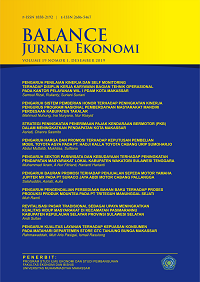Analyzing the Impact of Labor Force and Unemployment on Poverty Rates in Gowa District
DOI: https://doi.org/10.26618/jeb.v21i1.18603
Labor, Unemployment and Poverty Rate
Abstract
This study aims to analyze the influence of labor force participation and unemployment on poverty rates in Gowa Regency, Indonesia. Employing a quantitative research design, the study utilizes time series data from 2014 to 2023, collected through observation and documentation techniques. The data were analyzed using multiple linear regression with the assistance of SPSS version 2.5. The findings reveal that labor force participation has a negative but statistically insignificant effect on poverty rates. This is evidenced by a t-value of -1.120, which is lower than the critical value of 1.894, and a significance level of 0.300 (p > 0.05). These results suggest that while higher labor participation may contribute to reducing poverty, the relationship is not statistically significant. Additionally, unemployment is found to have a positive but similarly insignificant effect on poverty, with a t-value of 0.010 and a significance level of 0.992 (p > 0.05). These findings indicate that changes in labor force participation and unemployment rates do not have a significant direct impact on poverty levels in the region. The study contributes to the discourse on labor market dynamics and socioeconomic development, providing empirical evidence for policymakers in designing effective poverty alleviation strategiesReferences
Ala’n, S. (2015). Introduction to business economics volume 1: Business and management expertise for vocational high school/vocational high school grade X. Jakarta: Erlangga.
Annur, R. A. (2013). Factors influencing poverty in Jekulo and Mejobo Districts, Kudus Regency in 2013. Economics Development Analysis Journal, 2(4), 409–426.
Ayu, D. S. (2018). Analysis of the influence of gross regional domestic product, open unemployment rate, human development index, population, and minimum wage on poverty in East Java Province (2010–2015)
Badan Pusat Statistik. (2023). Data on poverty, unemployment, and labor force participation in Gowa Regency.
Fadillah, N., & Sabar, W. (2023). The effect of government spending and economic growth on unemployment and poverty in Gowa Regency. Bulletin of Economic Studies (BEST), 3(1), 25–37.
Febrianti, L., Agussalim, Hamrullah, & Atmansyah, L. (2022). Analysis of factors affecting regional poverty levels: A case study of Gowa Regency. Development Policy and Management Review, 2(1), 22–45. https://journal.unhas.ac.id/index.php/DPMR/
Fitrianti, A. N., & Alimuddin, C. (2016). Analysis of work motivation towards employee performance at Carrefour Karebosi Link in Makassar City. Balance Economic Journal, 12(1), 1–15.
Haliding, S., Alfiani, A., Majid, J., Badollahi, I., & Marsuni, N. S. (2025). Digitalization and Strategic Development in Enhancing Islamic Pawnshop Products for Financial Inclusion. INVOICE: JURNAL ILMU AKUNTANSI, 7(1), 37-45.
Hamzah, B. (2014). Motivation theory and its measurement. Jakarta: Bumi Aksara.
Itang, I. (2015). Factors causing poverty. Tazkiya, 16(1), 1–30.
Kristin, A., & Darsana, I. B. (2018). The effect of inflation and education on unemployment and poverty in Bali Province. E-Jurnal Ekonomi Pembangunan Universitas Udayana (EP Unud), 9(6), 1373–1401.
Maipita, I. (2014). Measuring poverty and income distribution. [Publisher not listed].
Putong, I. (2013). Economics: Introduction to micro and macro economics. Jakarta: Ghalia Indonesia.
Putri, E. S. (2017). Analysis of the influence of inflation, unemployment, and democracy on poverty in Indonesia [Undergraduate thesis, University name not listed].
Safitri, E. S., Triwahyuningtyas, N., & Sugianto. (2022). Analysis of factors affecting poverty levels in Banten Province. SIBATIK Journal: Scientific Journal in Social, Economic, Cultural, Technology, and Education, 1(4), 259–274. https://doi.org/10.54443/sibatik.v1i4.30
Septiadi, D., & Nursan, M. (2020). Poverty alleviation in Indonesia: Analysis of macroeconomic indicators and agricultural policy. Hexago, 4(1), 1–14.
Setyawan, H. (2021). Analysis of the influence of population and human development index on poverty levels in districts/cities in East Java Province in 2017–2020. JIE Journal of Economics, 5(3), 563–578. https://doi.org/10.22219/jie.v5i3.18748
Sari, J. (2021). Analysis of the influence of the number of workers, education level, and government expenditure on economic growth in North Sumatra [Doctoral dissertation, University of North Sumatra].
Sugiono. (2014). Qualitative, quantitative, and R&D research methods. Bandung: Alfabeta.
Siti Amalia. (n.d.). [No additional information provided – please verify].
Sukirno, S. (2017). Macroeconomics: Introductory theory (3rd ed.).
Sukmaraga, P., & Hayati, B. (2011). Analysis of the influence of human development index, GRDP per capita, and number of unemployed on the number of poor people in Central Java Province. Diponegoro University [Thesis].
Todaro, M. P., & Smith, S. C. (2006). Economic development (9th ed., Vol. 1). Jakarta: Erlangga.
Widayati, H. W., Laut, L. T., & Destiningsih, R. (2019). The effect of number of workers, education level and number of unemployed on economic growth of Magelang Regency 1996–2017. DINAMIC: Directory Journal of Economic, 1(2), 182–194.
Yanthi, C. I. D. P., & Marhaeni, A. A. I. N. (2015). The influence of education, wage level, and unemployment on the percentage of poor population in regency/city of Bali Province. Pyramid, 11(2), 68–75.












